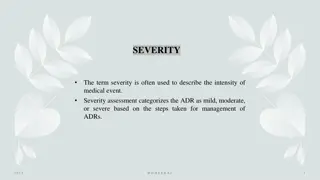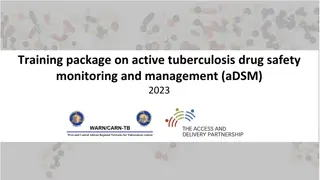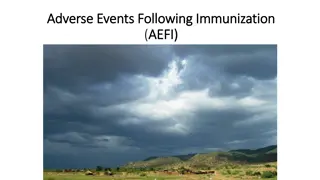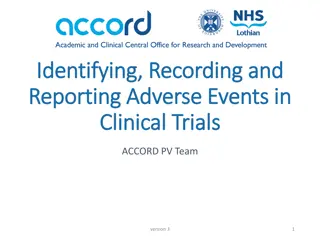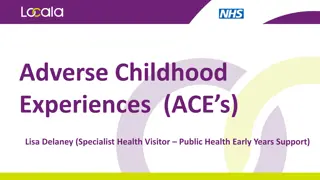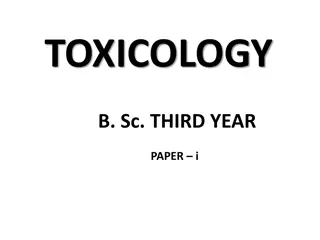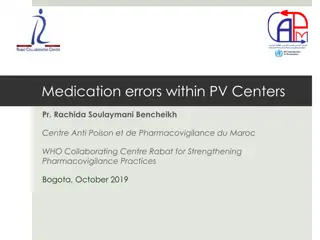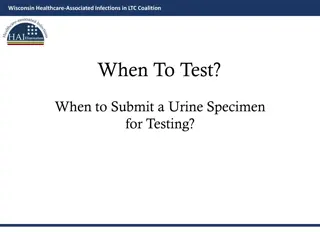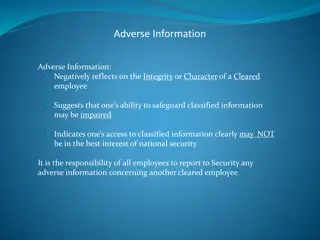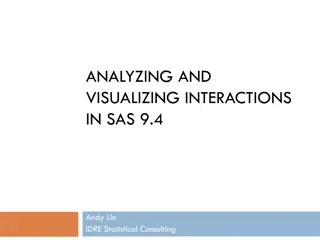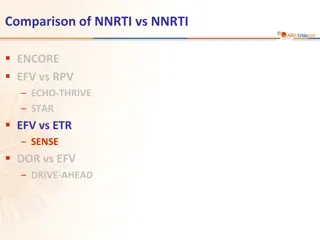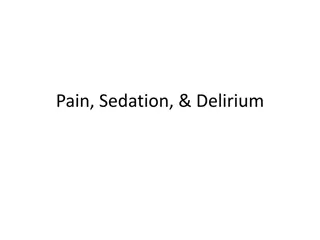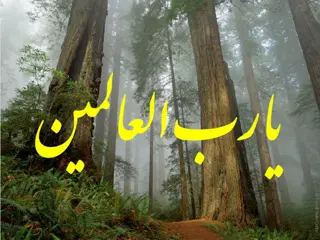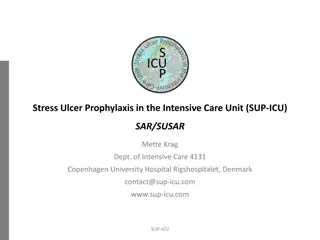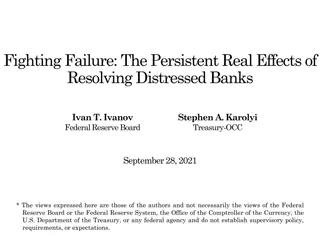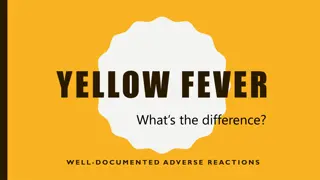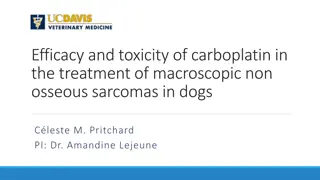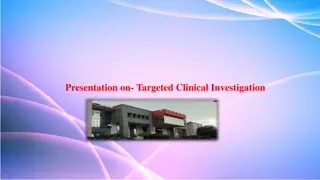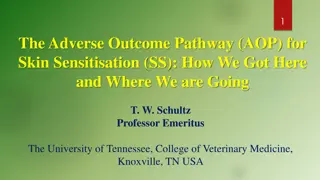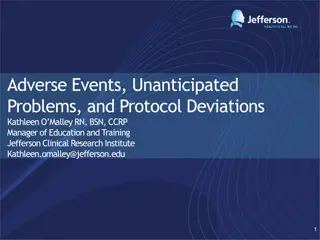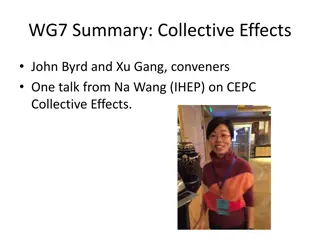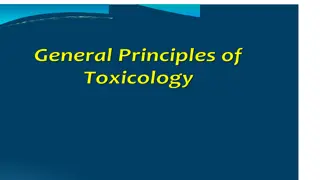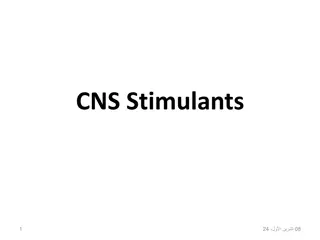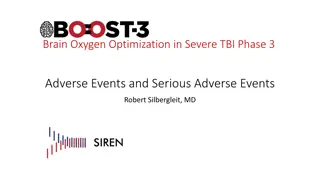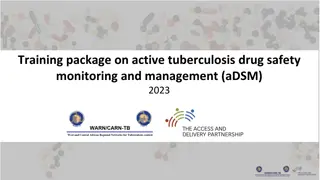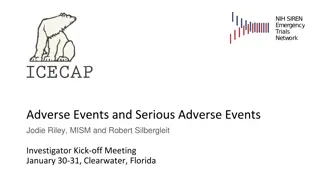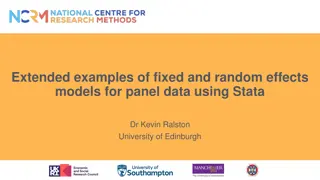Ticagrelor Monotherapy vs. 12-Month Dual Anti-Platelet Therapy After Coronary Stent Implantation for ACS
The study compares the efficacy of ticagrelor monotherapy after less than 1 month of dual anti-platelet therapy (DAPT) to 12-month ticagrelor-based DAPT in patients with acute coronary syndrome (ACS) undergoing percutaneous coronary intervention (PCI) with drug-eluting stent implantation. The aim is
1 views • 19 slides
Severity Assessment in Adverse Drug Reactions
The concept of severity assessment in adverse drug reactions (ADRs) categorizes the intensity of medical events into mild, moderate, severe, or lethal categories based on the required management steps. Various classification systems such as Karch and Lasagna, as well as modified Hartwig's and Siegel
4 views • 10 slides
Active Tuberculosis Drug Safety Monitoring and Management Training Package 2023
This training package focuses on the safety monitoring and management of active tuberculosis drugs, specifically emphasizing causality assessment in determining adverse reactions. Participants will learn about assessing the likelihood of TB medicines causing adverse events, attributing relationships
3 views • 17 slides
Overview of Serious Adverse Reactions and Transfusion Events
This data compilation covers the reporting trends, breakdown of reports, components issued, and specific types of adverse transfusion reactions experienced within the National Healthcare Organization (NHO) from 2019 to 2022. The information includes statistics on Serious Adverse Events (SAE), Seriou
2 views • 46 slides
Adverse Events Following Immunization (AEFI)
Adverse Events Following Immunization (AEFI) are medical incidents that occur after immunization, potentially caused by the vaccine, leading to unfavorable symptoms. Pharmacovigilance plays a crucial role in detecting, assessing, and preventing these events. AEFI can impact immunization programs at
5 views • 40 slides
Adverse Events in Clinical Trials
This presentation covers the identification, recording, and reporting of adverse events in clinical trials conducted by University of Edinburgh and/or NHS Lothian. It includes definitions, examples of adverse event recording, SAE form completion, and common mistakes. AEs can range from minor issues
0 views • 35 slides
Association of Renal and Cerebral Near-Infrared Spectroscopy with Adverse Outcomes in Single Ventricle Patients after Stage I Palliation
Study investigates the association between renal and cerebral near-infrared spectroscopy (NIRS) values and low cardiac output syndrome in single ventricle patients post Stage I palliation. Data from infants who underwent surgery between 2010-2019 is analyzed to determine correlations with adverse ou
1 views • 13 slides
Impact of Adverse Childhood Experiences (ACEs) on Individuals and Society
Adverse Childhood Experiences (ACEs) encompass a wide range of traumatic events during childhood that can have long-lasting effects on individuals. These experiences, such as abuse, neglect, and family issues, can significantly increase the risk of developing harmful behaviors and health conditions
1 views • 15 slides
Introduction to Toxicology: Science and Impact on Living Organisms
Toxicology is the study of adverse effects of chemicals on living organisms. It assesses probability of occurrence, quantitatively and qualitatively analyzing toxic effects. Toxicants are agents causing harmful responses in biological systems. Environmental toxicology focuses on pollutants' effects
0 views • 12 slides
Analyzing Interaction Effects in Composite-Based SEM
Explore the concept of interaction effects in composite-based structural equation modeling (SEM) through topics like the logic of interaction, estimating effects, multigroup analysis, and visualizing effects. Learn about moderators, their role in relationships between variables, and techniques for a
1 views • 23 slides
Medication Errors in Pharmacovigilance Centers
Adverse drug reactions resulting from medication errors are a significant concern faced by pharmacovigilance centers. This content discusses the importance of this problem, contributing factors, the relevance to pharmacovigilance centers, and strategies for managing medication errors. It highlights
5 views • 29 slides
Understanding the Effects of Trauma on Health: Insights from Trauma-Informed Care Implementation
Individual trauma and adverse childhood experiences can have lasting effects on mental, physical, social, and emotional well-being. The Trauma-Informed Care Implementation Resource Center provides valuable insights on defining trauma, examples of traumatic events, prevalence statistics, and types of
1 views • 11 slides
**Wisconsin Healthcare-Associated Infections in LTC Coalition: Urine Testing Guidelines**
The Wisconsin Healthcare-Associated Infections in LTC Coalition provides guidelines on when to test and submit urine specimens for testing in long-term care facilities. The focus is on reducing unnecessary urine testing, introducing tools like the UTI Stoplight Tool and the When To Test-Nursing Tool
5 views • 16 slides
Adverse Information Reporting in National Security
This detailed content covers the importance of reporting adverse information regarding cleared employees in national security settings. It outlines the impact of adverse information on security clearances, the 13 adjudicative guidelines used in determining eligibility for sensitive duties, NISPOM re
0 views • 15 slides
Interaction Effects in Regression Analysis using SAS 9.4
Regression models help analyze effects of independent variables (IVs) on dependent variables (DVs, like weight loss from exercise time). Interactions explore how one IV's effect can be modified by another IV (moderating variable, MV). In this seminar's purpose, techniques to estimate, test, and grap
0 views • 137 slides
Comparison of NNRTI vs. NNRTI in SENSE Study
The comparison between Etravirine (ETR) and Efavirenz (EFV) in the SENSE Study showed differences in neuropsychiatric adverse events, treatment response, and patient characteristics. ETR with 2 NRTIs resulted in fewer drug-related adverse events than EFV with 2 NRTIs. ETR also showed better response
0 views • 7 slides
Pain, Sedation, & Delirium Management in Critical Care
Effective management of pain, sedation, and delirium is essential in critical care settings to optimize patient comfort, facilitate recovery, and ensure better outcomes. The goal is to control pain adequately, minimize sedative use, and address indications for analgesia and sedatives while being min
0 views • 23 slides
Importance of Iodine Nutrition During Pregnancy
Iodine is essential for thyroid hormone synthesis, crucial for neurological development in utero and early life. Adequate iodine levels prevent adverse effects like decreased IQ, goiter, hypothyroidism, and hyperthyroidism. Mild to moderate iodine deficiency in pregnant women can have adverse outcom
0 views • 21 slides
Stress Ulcer Prophylaxis in ICU - Adverse Reactions Reporting Guidelines
Guidelines for reporting adverse reactions in Stress Ulcer Prophylaxis in the Intensive Care Unit (SUP-ICU), including definitions of Adverse Reactions (AR), Serious Adverse Reactions (SAR), Adverse Events (AE), Serious Adverse Events (SAE), SARs in SUP-ICU, and SUSARs. Specific conditions considere
0 views • 8 slides
The Real Effects of Resolving Distressed Banks
This study delves into the lasting impact of resolving distressed banks on the economy, showcasing significant compliance with regulatory thresholds and persistent adverse effects on local economies post-resolution. Findings suggest a notable drop in employment and establishments, with effects inten
0 views • 18 slides
Yellow Fever: Adverse Reactions and Risks
Yellow fever vaccination can lead to severe adverse reactions like anaphylaxis, neurotropic disease, and viscerotropic disease. These reactions can range from immediate hypersensitivity to rare but serious outcomes such as meningitis and multiple system organ failure. The mortality rate associated w
0 views • 11 slides
Media Effects on Development: Strong, Limited, and Nil Impact (Continuation)
American psychologists have traditionally believed in strong media effects, attributing direct influence on audiences. However, the limited effects theory emerged in the 1940s, challenging this notion by suggesting media's negligible impact on behaviors such as voting. On the other hand, proponents
0 views • 6 slides
Efficacy and Toxicity of Carboplatin in the Treatment of Canine Non-Osseous Sarcomas
The study evaluates the efficacy and toxicity of carboplatin in treating macroscopic non-osseous sarcomas in dogs. The research focuses on soft tissue sarcomas (STS) and mesenchymal tumors, exploring carboplatin's limitations, response rates, and toxicity profiles. Aimed at determining the drug's ef
0 views • 15 slides
Targeted Clinical Investigation in Pharmacovigilance
Targeted clinical investigation plays a crucial role in pharmacovigilance by further evaluating significant risks identified in pre-approval clinical trials. This involves conducting pharmacokinetic and pharmacodynamic studies, genetic testing, interaction studies, and large simplified trials to ass
1 views • 12 slides
Skin Sensitisation through Adverse Outcome Pathways (AOP)
The Adverse Outcome Pathway (AOP) for Skin Sensitisation provides a mechanistic framework linking Molecular Initiating Events (MIE) to Adverse Outcomes (AO) through Key Events (KE) and Key Event Relationships (KER). AOPs offer a transparent justification for toxicological predictions and play a vita
0 views • 21 slides
Adverse Events and Unanticipated Problems in Clinical Research
Explore the significance of adverse event reporting in clinical research, including definitions of adverse events (AEs) and serious adverse events (SAEs), as well as unanticipated problems (UAPs). Learn about the responsibilities of Investigators, Clinical Research Coordinators (CRCs), and Sponsors
0 views • 63 slides
Overview of Narcotic Analgesics and Opioids
Narcotic analgesics, such as opiates and opioids derived from opium, interact with specific opioid receptors in the body to produce analgesic effects. Different opioid receptors have varying effects, with mu (MOP) being a good analgesic but with adverse effects, delta (DOP) and kappa (KOP) have nuan
0 views • 6 slides
Collective Effects in High-Energy Physics Facilities
Collective effects play a crucial role in Higgs factories and high-energy physics facilities. Impedance effects are proportional to beam-induced voltage, with peak bunch current impacting SB effects and average current affecting MB effects. Factors like beam loading compensation and detuning of the
0 views • 5 slides
Toxicology and Measures of Toxicity
Toxicology is the study of the adverse effects of chemicals on living organisms, involving xenobiotics and poisonous substances. Toxicologists examine the nature of these effects, testing in lab animals for measures of toxicity such as mortality, teratogenicity, carcinogenicity, and mutagenicity. Ke
0 views • 18 slides
Overview of CNS Stimulants and Their Effects on the Body
CNS stimulants are drugs that primarily act on the central nervous system, with two main groups being psychomotor stimulants and hallucinogens. Common examples include caffeine, theophylline, and nicotine. These stimulants can have various effects on the body, such as increasing alertness, heart rat
0 views • 14 slides
Brain Oxygen Optimization in Severe TBI: Adverse Events Analysis
This study led by Dr. Robert Silbergleit focuses on adverse events in brain oxygen optimization for severe Traumatic Brain Injury (TBI) patients. It outlines key points for reporting adverse events, discusses relatedness algorithms, and presents scenarios to analyze adverse events occurrence post-en
0 views • 24 slides
Medications in Acute Care: Impact on Physical Therapy
Side effects of medications in the acute setting can manifest as impairments in various body systems, including integumentary, musculoskeletal, cardiovascular/pulmonary, and neuromuscular systems. Factors influencing adverse drug events include pharmacokinetics, drug interactions, and patient-specif
0 views • 24 slides
Covid-19 vaccine side effects
Countries like the UK, Norway, and Denmark have restricted COVID-19 vaccines for young people. Florida's Surgeon General advised men aged 18-39 to abstain due to increased heart-related deaths post-vaccination. Pfizer's disclosed side effects are concerning, including a list of adverse events of spe
0 views • 11 slides
Training package on active tuberculosis drug safety
This training package focuses on defining common terms in active TB drug safety monitoring, differentiating adverse events and treatment outcomes, and outlining the role of pharmacovigilance in detecting, understanding, and preventing drug-related issues. It provides insights into active TB drug saf
0 views • 14 slides
Immune Checkpoint Inhibitors: Adverse Effects and Management
Adverse effects of immune checkpoint inhibitors, focusing on a case study of immune-mediated colitis in a 61-year-old woman undergoing combination ICI therapy. Covers investigations, management strategies, and clinical lessons for handling immune-related adverse events.
0 views • 6 slides
Doctors' Learning on Drug Action & Adverse Reactions
Medical schools teach doctors about drug action, including adverse reactions, to ensure safe prescribing practices. Dr. John Halliday explains the importance of understanding treatment principles, patient views, medication safety, and adverse drug reactions in medical education. Recent studies in th
0 views • 12 slides
Adverse Events and Serious Adverse Events
Adverse events (AEs) and serious adverse events (SAEs) play a crucial role in clinical trial reporting. AEs are untoward medical occurrences in subjects, while SAEs are more severe outcomes. Proper reporting and classification of these events are vital for the integrity of study data. Learn about th
0 views • 34 slides
Extended Examples of Fixed and Random Effects Models for Panel Data Analysis
Fixed and random effects models in panel data using Stata, as presented by Dr. Kevin Ralston from the University of Edinburgh. Learn about the structure of panel data, the Fixed Effects (FE) model which controls for stable unobserved variables, and the Random Effects (RE) model which considers rando
0 views • 9 slides
Microchip Adverse Reactions
Addressing adverse reactions to microchips is crucial for pet owners and veterinarians. Understand the types of reactions, importance of reporting, and procedures to follow for both medical and commercial reasons. Learn how to support veterinarians, report adverse reactions, and handle cases of lack
0 views • 7 slides
PENS Trial Adverse Event Reporting: How to Report SAEs and AEs
In the PENS trial, learn about reporting Adverse Events (AEs) and Serious Adverse Events (SAEs). Understand the criteria, relatedness, expectedness, and process of reporting to ensure patient safety and protocol compliance.
0 views • 17 slides

